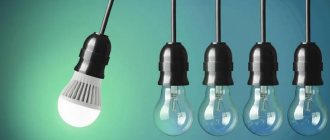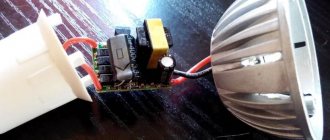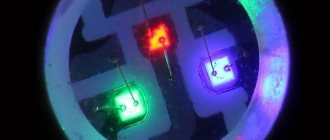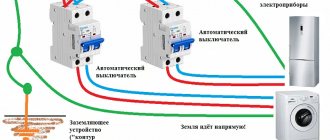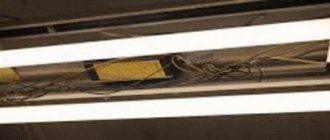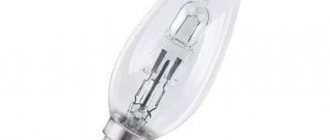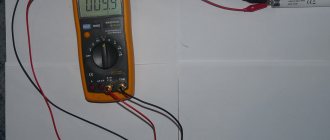Lighting devices are constantly being improved. This process can be easily traced, starting from the moment the “Ilyich light bulb” appeared. As a result of modernization, in addition to direct filament lamps, fluorescent options have appeared, and in modern conditions, replacing fluorescent lamps with LED devices is quite an urgent task.
Society strives for the best, and this is obvious. The main criteria for aspirations are convenience, comfort and, of course, savings. But how to perform the replacement correctly and what should you remember? We will consider these issues in detail in our article, we will understand the features of LED and fluorescent light bulbs, their pros and cons.
We will also provide recommendations for choosing a suitable light bulb and step-by-step instructions for replacing the device.
Is it worth replacing fluorescent light bulbs with LED lamps?
The lighting market is being massively filled with LED lamps of various formats, with characteristics attractive to those who like to save money. Given the rise in electricity tariffs, many manufacturers are speculating on this problem, promoting their products as eternal, efficient and at the same time economical. In reality, everything is not as rosy as marketers describe and replacing fluorescent lamps with LED lamps will be profitable if you purchase very expensive devices. The properties attributed to LEDs correspond to the products of branded lighting manufacturers. As a rule, the cost of their products goes through the roof, negating all the benefits of refurbishment. This is how, in the understanding of manufacturers of LED elements, the comparative characteristics of their products with fluorescent lamps look like.
By and large, with a certain combination of devices, the presented characteristic corresponds to reality, since there are bad fluorescent lamps and good LED lamps. The key factor determining the effectiveness of a particular lamp is the price. But if we take the average range, then everything looks a little different.
Are there any savings in this?
Using the passport data of specific lamp models from one manufacturer, you can calculate the cost of operating a lamp for a certain period of time. In the case of Navigator and Osram, the calculation table is as follows.
Based on calculations, the most expensive of the presented devices are incandescent and halogen lamps. The cost of operating LEDs is comparable to gas-discharge energy-saving lamps, but fluorescent lamps, even with a power of 36 W versus 8 W for LED lamps, are cheaper. LED lamps begin to pay for themselves only after 4,000 hours, and become more profitable than energy-saving lamps after 25,000 hours of operation, as can be seen in the graph.
To be fair, it is worth noting that the service life of branded LED elements of 50,000 hours allows them to be oriented for the long term, while fluorescent ones will have to be replaced after 20,000-30,000 hours.
Installation and replacement of fluorescent lamps with LED ones
You can see a detailed installation with all the details in the video below:
How to replace lamps with LED ones? For replacement, models of devices are selected whose executive and overall dimensions differ little from the lamps of the previous design. The lamps can be installed either as a non-suspended ceiling or on special cables (beneficial for high rooms).
The LED lamp body is fixed using self-tapping screws with plastic washers. This is important for devices that are installed on the first floors of multi-story buildings: in the event of a sudden increase in humidity (in particular, when the apartment is flooded by neighbors above), this will save the system from a short circuit.
To prevent overheating between the rear end surface of the lamp and the ceiling/wall, it is better to provide a guaranteed gap of 15...20 mm. It is strictly prohibited to install LEDs in the thermal zone of ceiling infrared heaters.
Please rate the article. We tried our best:)
Did you like the article? Tell us about her! You will help us a lot :)
Differences in work
Despite the possible external similarity of T8 lighting sources, fluorescent and LED lamps operate on different principles. The fluorescent light source is a glass flask filled with mercury vapor. When high-frequency voltage is applied to the electrodes, mercury ions emit light in the ultraviolet range. To convert ultraviolet light into the spectrum visible to the eye, a special phosphor is sprayed onto the inner surface of the glass bulb, which glows under the influence of UV rays in the visible range. Hard ultraviolet radiation is not transmitted. To start gas discharge, a throttle with a starter is required.
The LED element glows due to the passage of a low-power current through the crystal in the luminescence range specified by the manufacturer, mainly in cool tones from 5,000 to 10,000 Kelvin. To start an LED lamp from a 220 V network, a driver or electronic ballast is required - an electronic ballast.
The main differences between halogen and LED
The first step is to figure out what differences they have.
This will allow you to make the most optimal decision for yourself and understand which lamps will be more effective in rain, wet weather, and whether it is worth installing LEDs on your car at all. Car enthusiasts prefer LED lamps
LED and halogen lamps are different types that are fundamentally different from each other. The key difference between semiconductors and gas-discharge light sources lies in the following indicators:
- higher light output;
- low energy consumption;
- increased service life in terms of duration;
- less load on the on-board power supply system.
Let’s compare: which lamps provide the most efficient and optimal lighting
As a result, drivers install LED lamps instead of halogen lamps in cars to improve the quality of light.
Advantages and disadvantages
If you compare these two radically different light sources, you can see that LEDs have numerous advantages:
- the ability to obtain an ultra bright beam of light;
- correct beam dispersion, which allows you to perfectly illuminate the road even in bad weather conditions;
- long service life, significantly exceeding any analogues.
LED lamps provide bright, correct and uniform lighting
Thanks to the reduced load on the on-board electrical network, we can talk about a slight reduction in consumption levels, which in the long term results in decent savings.
The energy consumption level of h4 LED lamps is 3-4 times lower than halogen lamps. Their installation will allow you to avoid voltage drops in the electrical network when a large number of energy-consuming devices are used, such as an interior heater, heated seats, mirrors, and rear window.
LED lamps have design differences. Removing the increased load on the battery and car generator extends their service life and eliminates premature failure.
Using LED h7, you can forget about the fact that some part of the road will be unlit. Also, thanks to the brightness of the headlights, it doesn't matter whether the road is illuminated by street lights or not, as the car's light will be sufficient. It is especially comfortable to drive with such headlights for long distances - your eyes will not get so tired on the road.
Replacing halogen lamps with LED lamps in a car can provide the driver with a number of positive aspects:
- The car's headlights will shine much brighter, which will increase the visibility of the vehicle on the road. Even from long distances, the car will be clearly visible to other road users.
- The appearance of the car will improve. Head optics, in which LED lamps are installed, transform the appearance of the car, making it more stylish and beautiful. The car will stand out among similar ones and become more noticeable.
LED lamps are undoubtedly the winner
The disadvantage of such replacement and installation is the fact that even with proper adjustment at close range they can blind oncoming cars.
Another disadvantage of semiconductor lighting sources is that they produce a beam of light that has a short range. This drawback is especially noticeable when driving at high speeds on the highway, which limits the driver's visibility.
The beam of light at high speed limits visibility
Halogen lamps have a longer illumination range. A bonus for other drivers - the lamps will not blind oncoming traffic.
The advantage of LED lighting in luminaires
LED lamps are widely installed instead of fluorescent lamps, since, all other things being equal, they are superior in some respects:
- environmental friendliness - fluorescent lamps contain toxic mercury. In this regard, disposal of gas discharges in the usual way is prohibited. The regulations require the delivery of used flasks to a special enterprise, and the cost of disposal starts from 8 rubles per unit. The LED element can simply be thrown into a container for solid household waste; if the structure is destroyed, it does not pose any danger to others;
- light output and performance - although most manufacturers claim the efficiency of LED lamps is 90%. In reality this figure is close to 40%. Taking into account energy losses in the driver, the efficiency of the LED lamp is reduced to 130 lumens per watt, which is 25-30%. However, even taking into account all the deductions, luminescent devices lose here too, since their maximum efficiency does not exceed 80 lumens/Watt - 20%. Considering the lack of developments in this direction, any improvements in gas discharge performance are not expected in the future;
- ergonomics - the operation of fluorescent lamps and ballasts is accompanied by humming, crackling, radio and audio interference for nearby electrical appliances. In addition, the coefficient of light pulsation of gas discharges at the moment of their start exceeds 20% versus 5-10% for LED lamps;
- stability - when voltage surges in the network, especially drops to 180 Volts, fluorescent lamps blink or go out. Cheap Chinese LED devices with a diode bridge instead of a voltage stabilizer also do not work correctly. But the use of high-frequency stabilizers in the circuit solves this problem;
- degradation - the phosphor crumbles and burns out over time, reducing light output and shifting the emission spectrum of the gas discharge into the dangerous ultraviolet range.
The main disadvantage of LED lamps is the price, which is still higher than their gas-discharge counterparts. Increasing accessibility comes through simplifying circuits and using ineffective parts, which eliminates part of the benefit from converting to a new type of lighting instead of outdated fluorescent tubes. Chinese products often work no longer than incandescent lamps, they get very hot and burn out, so their operation becomes even more expensive due to the forced replacement of the light source after it breaks down.
Types of LED lamps
There are special designs of LED lamps, the appearance of which resembles a fluorescent lamp and other lighting devices of this type.
They are a tube with a power supply and can be manufactured in the following options, depending on the material:
- Tube with a diameter of 26 mm made of solid transparent or matte polycarbonate. Due to their strong glow, such LEDs are placed in closed lampshades. Matte coatings partially absorb the light flux, and this factor should be taken into account when calculating power.
- Double-sided design. On the outside there is a part of the body made of a chemical alloy, and on the rear there is a round aluminum profile. Matte or transparent material is used as a diffuser.
Some types of lighting fixtures are equipped with a rotating mechanism that allows you to adjust and direct the light flux in the desired direction at a given angle. All tubes have standard lengths of 600, 900, 1200 and 1500 mm.
In residential premises, instead of a fluorescent lighting system, it is recommended to install lamps with a length of 600 and 1200 mm, which have sufficient power and optimal luminous flux. The power of the lamps varies between 9-25 W, including 18 W, and the light emitted can be cold or warm.
The LEDs and power supply are located inside the tube on a special getinax strip. Such lamps do not require an external source, and are connected directly to the electrical network. Power is supplied to pins located in the base and connected by copper wire. The T8 design practically does not need to be modified and the problem of how to remake it needs to be solved. After removing unnecessary parts, the device can be immediately connected and put into operation.
Rework procedure
If replacing an incandescent or housekeeper lamp with an E27, E14 socket with an LED of the same format and dimensions is not difficult, then installing a T8 lamp with a G13 socket already requires some adjustments in the design of the original lamp.
The letter G means connection using two pins, and the number 13 is the distance between them in millimeters.
To start gas discharge, an electronic ballast or a choke with a starter is used, and these elements must be excluded from the circuit.
Procedure for replacing lamps
Actions to replace T8 lamps instead of fluorescent lamps are carried out in a certain sequence:
- The work area where the lamps need to be installed is first de-energized by turning off the circuit breaker.
- The protective cover is removed so that free access to the elements is directly provided.
- The LED lamp connection diagram involves removing the inductor, capacitor and starter from the circuit. The wires connected to the cartridge terminals are disconnected, after which they are connected directly to phase and neutral.
- The remaining wires not involved in the circuit are insulated or completely removed.
- The lamp with T8 G13 LEDs is inserted into its place, after which the LED lamp is connected and its functionality is checked.
The contact pins are marked with the corresponding letters L and N printed on the base. If a fluorescent lamp has an electronic ballast - electronic ballast, which is much easier to upgrade. In this case, the wires leading to the ballast are simply cut or soldered off. Next, phase and zero are connected to the wires in the left and right socket. The connection point is insulated, after which the LED lamps are installed and voltage is supplied.
Options for using backlights
As an example, let's look at options for using backlights in Legrand products.
The backlight mode in the illustration is indicated by a picture of the month, the installation of a switch with an operation indication is indicated by a picture of a light bulb.
A single-key switch with night illumination is connected according to the classical scheme: a light bulb on contacts L. To indicate operation, a working zero must be set to the backlight lamp.
Connecting a two-key switch is done in the same way. Each operating line has a separate indicator light. The circuit provides separate indication of the double switch, each backlight works for its own line.
The three-key switch works exactly the same way. There will only be three indicators. By the way, this is another argument for opponents of the backlight: a three-key switch in display mode spends 3 times more energy than a double switch.
The pass-through switch can also work with backlight. Only the switching diagram will be different. The indicator is connected to those contacts that will be open when the key is in the “down” position. As a result, if you turn on the light with one of the “pass-throughs”, the backlight on it goes out.
When using the backlight as an indication of lamp operation, the indicator is connected to the lamp side, and a separate working zero is connected to it. Regardless of the position of the “feeders”, when the lighting is turned on, the indicator will light up.
Legrand sells backlight lamps separately. In essence, it is an ordinary LED with a quenching resistor and a freewheeling diode, packaged in a heat-shrinkable tube.
If you don’t want to overpay for the logo on the price tag, you can make a spare indicator yourself. The circuit is simple: in order to prevent reverse current from flowing through the LED element (we have alternating voltage in the network, the polarity changes with a frequency of 50 Hz), a reverse diode (type D226) is installed. And since the voltage drop across the LED is 2–3 volts (depending on the color), a current-limiting resistor is installed in the circuit. Diagram and part values in the illustration:
Any switch can be equipped with such an indicator, the main thing is that the light breaks through the plastic.
We’ve figured out how to install a backlit switch, now we’ll deal with stray light. Cunning craftsmen are already offering for sale certain modules that are connected in parallel with housekeepers and LED lamps.
In fact, these are ordinary load resistors. They actually block unwanted light while using as much energy as a low-wattage incandescent lamp. That is, your lights are turned off, but the meter continues to wind.
To “make friends” between a backlit switch and LED (economical) lamps, you need a pass-through switch.
You connect a working lamp to one output, and an indicator with a separate working zero to the second. In this case, the phase works only for one consumer: either the main lamp or the indicator. In principle, there can be no parasitic glow.
Yes, the connection circuit is more complicated (you will have to draw the neutral wire). But you have to pay for the comfort of use. Electricity consumption is minimal, power no more than 1 watt.

